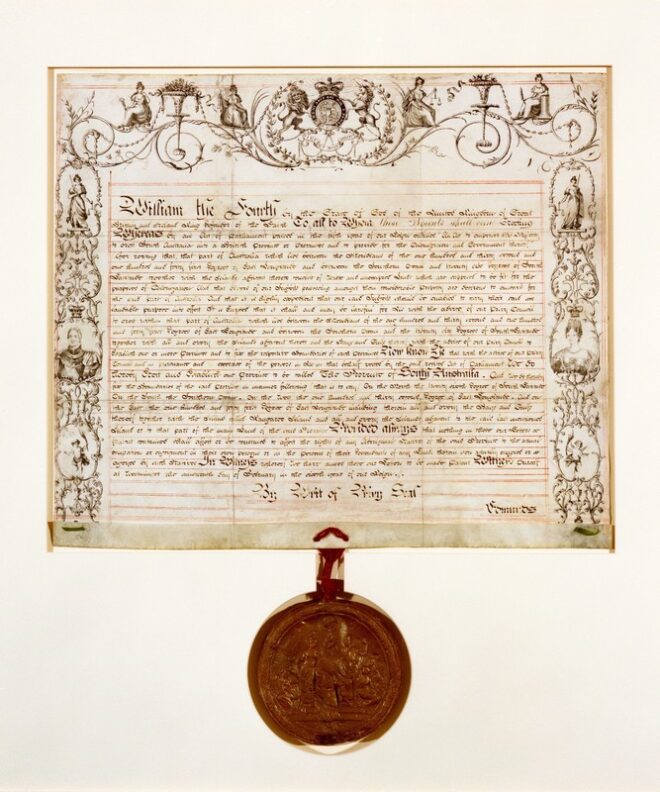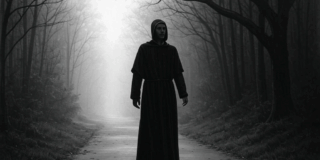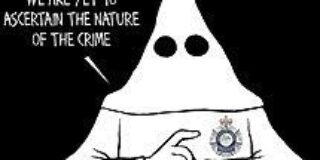
In 1838, Governor George Gawler addressed the Kaurna people of South Australia in a speech translated into their language: “Black men! We wish to make you happy. But you cannot be happy unless you imitate white men. Build huts, wear clothes, work and be useful. Above all you cannot be happy unless you love God who made heaven and earth and men and all things. Love white men. Love other tribes of black men. Learn to speak English. If any white man injure you, tell the Protector and he will do justice.” Far from benevolent, this speech was a colonial directive to erase Kaurna cultural identity by imposing European norms, aligning with British imperial goals of control and exploitation. The Kaurna resisted through diverse strategies – preserving traditional practices, language, spirituality, and community ties – demonstrating resilience against this assault on their way of life.
A striking fictional parallel appears in H.G. Wells “The Island of Dr. Moreau” (1896), where the Beast Folk, animals surgically altered to resemble humans, recite a ritualistic Law to enforce their “humanity.” Their chant, “Not to go on all-fours; that is the Law. Are we not Men? Not to suck up Drink; that is the Law. Are we not Men?” proclaims adherence to human behaviors, driven by fear of Dr. Moreau’s House of Pain. Like Gawler’s speech, this ritual seeks to transform “others” into a prescribed ideal, revealing shared themes of control, identity manipulation, and resistance. By comparing these texts, enriched with additional examples and broader context, this paper explores how the Kaurna and Beast Folk navigated imposed identities, resisted erasure, and exposed the violence of assimilationist projects, whether colonial or scientific, while highlighting the enduring power of defiance in asserting identity.
Gawler’s Speech: A Colonial Mandate for Assimilation
Gawler’s speech encapsulates British colonial ideology, presenting European culture as the sole path to “happiness.” The opening, “We wish to make you happy,” feigns benevolence, but the condition – “you cannot be happy unless you imitate white men” – reveals its coercive core. The Kaurna are instructed to adopt European housing (“build huts”), clothing, labor (“work and be useful”), religion (“love God”), language (“learn to speak English”), and loyalty (“love white men” and “other tribes”). These directives dismiss Kaurna practices: semi-nomadic wiltjas suited to seasonal mobility, minimal attire adapted to the climate, economies tied to hunting and reciprocity, spirituality rooted in Dreaming, and a language encoding laws and place-based knowledge.
The promise of justice – “If any white man injure you, tell the Protector and he will do justice” – is hollow. Protectors, like William Wyatt in 1840, often mediated disputes – like Kaurna complaints over settler theft of yams – to favor colonists, reinforcing power imbalances. The speech’s implications are stark: assimilation is non-negotiable, and Kaurna survival hinges on cultural surrender. Its broader meaning aligns with global colonial strategies, where “civilising” rhetoric masked land dispossession and labor exploitation. By 1838, Adelaide’s rapid expansion had disrupted Kaurna camps, water sources, and sacred sites, such as the Red Kangaroo Dreaming near Karrawirra Parri (River Torrens). Gawler’s words were a direct threat, demanding compliance amid escalating colonial pressures.
Kaurna Resistance: Defending Culture Against Erasure
Kaurna resistance was multifaceted, reflecting their deep connection to country and community. Despite lacking written records of their immediate reactions – due to their oral culture and colonial documentation biases – historical accounts reveal their agency.
1. Continuation of Traditional Practices
The Kaurna defied calls for permanent huts by maintaining seasonal mobility. They returned to sites like Pirltawardli (near modern Adelaide) for ceremonies and resource gathering into the 1840s, as noted in settler journals. For example, in 1839, Kaurna groups camped at Tulya Wodli (Bonython Park), performing corroborees despite settler complaints, affirming cultural continuity. Their fire management practices, used to sustain ecosystems, continued covertly, countering colonial agriculture’s disruption, as seen in controlled burns near Glenelg in 1841.
2. Linguistic Preservation
The demand to “learn to speak English” targeted Kaurna language, a vessel for stories and laws. They resisted by teaching children terms like “Tarntanya” (Adelaide) and “ngadlurlu” (elder). At Piltawodli school, established in 1839, Kaurna students used their language alongside English, preserving phrases like “yarta” (land), as recorded by missionaries. This ensured oral traditions endured, laying the foundation for modern revitalisation efforts.
3. Spiritual Resilience
Gawler’s call to “love God” aimed to replace Dreaming with Christianity. The Kaurna engaged selectively, attending Dresden Mission for food or blankets while holding rituals privately. In 1841, a corroboree near Adelaide reenacted Dreaming stories, defying mission influence. Figures like Monarto, a Kaurna leader, balanced Christian names with traditional roles, maintaining spiritual autonomy.
4. Social Cohesion and Strategic Engagement
The directive to “love white men” sought to reorient loyalties. Instead, the Kaurna strengthened ties with groups like the Ngarrindjeri, coordinating protests, such as the 1839 fishnet ban resistance at Encounter Bay. Leaders like Mullawirraburka and Kadlitpinna worked as intermediaries, securing resources – blankets, flour – for kin, as in 1840 negotiations with settlers, rather than fully assimilating. These acts prioritised community survival over colonial allegiance.
5. Overt Defiance
Overt resistance included protests against land theft. In 1840, Kaurna blocked settler access to water at Onkaparinga, reclaiming resources, and in 1841, they drove cattle off yam grounds near Adelaide, as documented by Protector Moorhouse. These actions, though risky, asserted rights against colonial encroachment.
This resistance ensured cultural fragments survived, enabling revival through initiatives like Kaurna Warra Pintyanthi, which restored language by 2025.
The Beast Folk’s Law: Scientific Control and Fragile Compliance
In ‘The Island of Dr. Moreau’, the Beast Folk’s Law parallels Gawler’s speech as an imposed transformation. Dr. Moreau creates human-like creatures, enforcing rules to suppress instincts. The Law’s chant – “Not to go on all-fours; that is the Law. Are we not Men?” – prohibits natural behaviors, like quadrupedal movement or eating flesh, with the House of Pain as punishment. For example, the Puma endures agony mid-transformation, and the Dog Man is tortured for relapsing, illustrating coercion’s brutality.
Like Gawler’s speech, the Law promises elevation – humanity – but demands conformity. It mirrors the Protector’s role, offering conditional protection through fear. The Law’s implications are grim: the Beast Folk’s “humanity” is artificial, sustained by pain. Its meaning critiques scientific hubris, paralleling colonial dehumanisation. Resistance emerges subtly: the Leopard Man hunts, violating “Not to chase other Men”; the Hyena-Swine eats forbidden flesh post-Moreau; the Sloth Creature reverts to all-fours; and the Wolf-Bear howls nocturnally, defying silence rules. Prendick notes their “grotesque” voices wavering, signaling doubt. These lapses undermine Moreau’s control, revealing the Law’s fragility.
Comparative Analysis: Shared Themes and Divergent Contexts
1. Imposed Identities and Control
Both texts impose identities to serve external goals. Gawler demands Kaurna emulate “white men,” aligning with colonial land and labor needs. Moreau’s Law forces Beast Folk to be “Men,” fulfilling his ambition to transcend nature. Both frame difference as deficiency – Kaurna culture as “savage,” animal instincts as “base.” Examples illustrate this: Gawler’s huts reject wiltjas’ environmental fit, like settler rejection of Kaurna yam cultivation in 1839; Moreau’s ban on all-fours ignores the Ape Man’s natural gait, seen in his secret climbing.
Control mechanisms converge. Gawler’s Protector, as in Mooronggalie’s 1839 ruling against Kaurna fish theft complaints, ensures dependency. Moreau’s House of Pain, where the Lion Man suffers for hidden kills, mirrors this. Surveillance – Protectors monitoring Kaurna, Moreau’s whip enforcing Law – fails to suppress resistance, as Kaurna protests and Beast Folk relapses show.
2. Resistance and Agency
Kaurna resistance is deliberate, rooted in culture. They maintained mobility, camping at Karrawirra Parri for ceremonies, as in 1842’s recorded gatherings. Linguistically, they preserved “kudnarto” (woman leader), used by Kaurna women in 1840s missions. Spiritually, they held rituals, like the 1843 fire ceremony near Port Adelaide, defying Christianity. Socially, Kadlitpinna’s 1841 mediation secured tools, redirecting benefits, akin to Mullawirraburka’s blanket deals.
Beast Folk resistance is instinctual. The Goat Creature’s bleating chant betrays compliance, and the St. Bernard Dog reverts to barking post-Law. Unlike Kaurna community efforts, their resistance is individualistic, reflecting artificial origins. Yet, both exploit gaps: Kaurna through labor, Beast Folk through lapses, like the Fox-Bear’s secret digging. Kaurna resistance enables revival; Beast Folk’s leads to collapse, highlighting cultural versus engineered contexts.
3. Ideological Parallels: Colonialism and Scientific Hubris
Both reflect superiority ideologies. Gawler’s Eurocentrism dismisses Kaurna fire management, as settlers ignored 1840 burns sustaining ecosystems. Moreau’s anthropocentrism deems the Puma’s pain “animal,” like colonial views of “savages.” Language enforces control: Gawler’s “you cannot be happy unless” and the Law’s “Are we not Men?” demand submission. Examples deepen this: Gawler’s “love white men” ignores Kaurna kinship, seen in respect for elders like Ityamaiitpinna; Moreau’s “not to eat Flesh” denies the Tiger Man’s instincts, observed in his nocturnal hunts.
Both critique power’s limits. Kaurna resistance, like their 1842 protest against sheep grazing, exposes hypocrisy. Beast Folk regression, as the Boar Man grunts during chants, mocks Moreau’s hubris. Wells’ Victorian era, with Darwinian and imperial debates, ties to Gawler’s missionary zeal, likening Indigenous peoples to “beasts” needing uplift.
4. Power Dynamics and Surveillance
Both texts reveal power through surveillance and punishment. Gawler’s Protector system, exemplified by Wyatt’s 1841 dismissal of Kaurna land claims, mirrors Moreau’s House of Pain, where the Rabbit Creature is punished for eating plants. The Kaurna subverted this by using Protector meetings to voice grievances, as in 1840 water disputes, while Beast Folk hid relapses, like the Owl Man’s nocturnal flights. These examples show resistance exploiting oversight’s cracks, challenging absolute control.
5. Legacy and Modern Resonance
Kaurna resistance preserved culture, enabling revival. Kaurna Warra Pintyanthi restored terms like “parna” (pathway), used in 2025 signage, and Adelaide Oval’s Tarntanyangga naming reclaims identity. Community events, like 2023’s Kaurna language festival, echo 1840s corroborees. Beast Folk collapse leaves no legacy, their “humanity” dissolving, as the Horse-Rhino returns to grazing. Yet, both resonate: Kaurna revival aligns with M?ori or Navajo language efforts; Beast Folk warn of dehumanisation, relevant to AI ethics or refugee policies.
Gawler’s speech exposes colonial lies, its “happiness” a control tactic, like unkept 1841 protection promises. The Law critiques progress, its “men” a farce, as the Sheep Creature’s bleating reveals. Both affirm resistance – Kaurna through culture, Beast Folk through nature – against oppressive ideals.
Historical Context: South Australia and Wells’ Victorian Lens
South Australia’s 1836 founding promised Indigenous equity, but by 1838, settler greed displaced Kaurna, as in Glenelg’s 1837 land grabs or 1839’s Port Adelaide clearances. Gawler’s speech aimed to pacify, reflecting Australian policies. Kaurna resistance – protests, like 1842’s yam ground defense, or language retention – countered this, despite losses to disease and missions by 1900.
Wells’ 1896 novel, set amid Darwinian debates and empire, probes human-animal divides. Beast Folk echo colonised subjects under missionary “Laws,” their resistance mirroring Kaurna agency. Both contexts reveal power’s fragility, whether colonial Adelaide’s tensions or the island’s unraveling order.
Broader Implications: Identity and Resistance
The comparison illuminates identity’s resilience. Gawler’s speech and the Law seek to redefine – Kaurna as “white,” Beast Folk as “men” – but resistance reclaims essence. Kaurna protests, like 1843’s fish trap defense, and Beast Folk lapses, like the Cat Creature’s claw-sharpening, reject imposed roles. Both critique systems – colonialism’s theft, science’s arrogance – showing resistance’s universal power, from cultural revival to instinctual rebellion.
Conclusion
Gawler’s 1838 speech and the Beast Folk’s Law impose identities – European for Kaurna, human for Beast Folk – through coercive rhetoric promising uplift but delivering control. Kaurna resisted through mobility, language, spirituality, and strategy, as in Pirltawardli camps or Tarntanya’s naming, ensuring revival. Beast Folk resisted instinctually, their relapses – like the Tiger Man’s hunts – exposing Moreau’s failure. Additional examples – Kaurna protests, Beast Folk regressions – deepen the comparison, revealing control’s limits. Both texts critique imposed ideals, affirming identity’s endurance, whether cultural or natural, against erasure’s violence.



